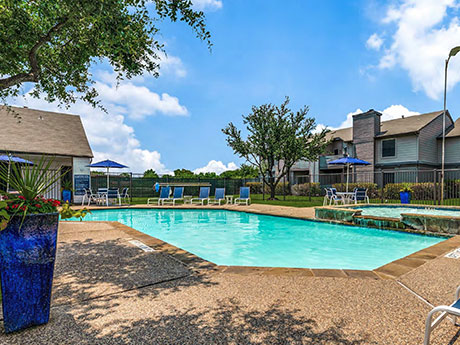The doubling of multifamily mortgage rates to around 6 percent since early 2022 as a result of the Federal Reserve’s monetary tightening efforts has rocked the commercial real estate investment sales market. The higher rates have fueled a stubborn bid-ask spread, and debt-service coverage requirements have limited the amount of leverage buyers can borrow to around 50 percent of an asset’s value, down from roughly 60 percent or more earlier this year.
The sharp uptick in the price of debt not only requires borrowers to raise more equity, but those who do secure loans may also have negative leverage. That scenario occurs when cash-on-cash returns fail to cover borrowing costs because multifamily capitalization rates are frequently lower than the interest rate.
This environment has been particularly difficult for investors who are on the clock to complete a 1031 exchange. These are buyers who have sold a property and want to defer paying capital gains taxes by buying a similar, or “like-kind,” asset with the sale proceeds under section 1031 of the U.S. Internal Revenue Code.
Despite attempts to repeal the tax-saving mechanism, real estate investors have used the tool for decades to build wealth by repeatedly deferring capital gains taxes on property sales. In addition to that benefit, properties left to heirs receive a step-up in basis upon the owner’s death, meaning that the property’s original cost basis is reset to its value on the day of passing. That effectively eliminates any past capital gains tax obligations.
But to qualify for the full tax deferral, 1031 exchange investors must satisfy a number of conditions. One of the most pressing requirements is that after the initial sale, an investor has 45 days to identify the so-called replacement property and 180 days to complete its purchase. In some cases, exchange buyers must choose whether to overpay for a multifamily asset and accept negative leverage or pay the capital gains tax. Some are choosing the latter.
“Investors who are in the middle of an exchange have been the hardest hit by the higher interest rates and turmoil in the market,” says Michael Wiener, a partner in the corporate finance and securities practice group of the Greenberg Glusker law firm in Los Angeles. “It’s harder to find a replacement property that can be reasonably acquired. Because of that, we’ve had a couple situations where investors have decided to pay the tax rather than invest in an unattractive deal.”
Shrinking Inventory

Exchange investors looking for a replacement property aren’t the only ones who have been affected by the interest rate environment. Property owners who want to sell and begin a 1031 exchange are now finding that their assets aren’t commanding the same price that they were a year ago, says Gabe Tovar, senior vice president of investment sales for Northmarq in Mission Woods, Kansas.
The firm recently represented a California buyer that paid $38.5 million for two loft properties in downtown Lawrence, Kansas, to complete a 1031 exchange.
“We’ve found ourselves in a precarious position where — after a decade of rising — multifamily prices have started to recede,” points out Tovar. “From the perspective of a 1031 exchange investor, the question becomes not whether it can sell the property, but at what price? Then the investor has to ask, ‘Can I find a suitable replacement property in the near term, or am I just dreaming given the lack of deals on the market?’”
Often, would-be sellers are deciding to hold onto their assets, reveals Andy Bratt, a principal with Gantry, a mortgage banking firm based in San Francisco. Earlier this year, Bratt secured $19 million in bridge financing for the acquisition of Ashton Apartment Homes in Saginaw, Texas, near Fort Worth. The buyer used the proceeds from an earlier sale to purchase the 152-unit, value-add asset as part of a 1031 exchange.

In April 2022, Gantry arranged roughly $19.1 million in bridge financing for the acquisition of Ashton Apartment Homes, a 152-unit multifamily project in Saginaw, Texas, for a 1031 buyer. The two-year loan includes three one-year extensions and a future funding component for the completion of value-add improvements.
“Unless owners are forced to sell because they have a closed-end fund, are in a partnership dispute or are going through a divorce — or because they have realized their business plan and are willing to take less of a return — they are sitting on the sidelines,” says Bratt, who is based in Gantry’s Irvine, California, office. “There’s just not as much inventory on the market as there was six to nine months ago.” Consequently, Tovar and Bratt are observing a growing interest in reverse 1031 exchanges, in which an investor buys the replacement property first and then sells a property. It is one solution to the low inventory problem, adds Tovar, but it is also inherently risky. “When you buy the asset first in a reverse exchange, you’re then betting on market stability over the next few months when you have to sell,” explains Tovar.
Apartments Remain Frontrunners
Amid the spike in interest rates, apartment sales, as with investment sales of most commercial real estate categories, have dramatically slowed in the second half of 2022. Sellers largely want the type of prices they were able to fetch a year ago, when the cost of capital was lower. That’s making deals less financially feasible and sending buyers to the sidelines.
Despite the slowdown, the multifamily sector remains the most sought-after commercial real estate category. Investment sales totaled $74.1 billion in the third quarter, a 17 percent decline compared with the same period a year ago, according to MSCI Real Assets, a New York-based research firm that tracks commercial real estate investment sales of $2.5 million and above.
Still, year-to-date multifamily sales of $238 million through the third quarter were more than twice the volume of industrial transactions, the next most active category, reports MCSI Real Assets.
Multifamily assets also remain a popular
replacement property among investors pursuing a 1031 exchange. That’s especially true for smaller and aging residential investors who want to leave behind the daily active management grind and trade up to higher quality
properties.
These investors place the proceeds into Delaware Statutory Trusts (DSTs), a turnkey structure in which a sponsor raises equity to acquire and manage properties on behalf of investors. DST shareholders receive monthly cash distributions and a potential return based on the asset’s appreciation at its sale.
DSTs have become extremely popular with 1031 exchange investors since 2004, when the Internal Revenue Service recognized DST shares as real property, and therefore, an eligible replacement property. DST sponsors raised $7.4 billion of equity in 2021, more than twice the amount raised in each of the previous two years, according to Mountain Dell Consulting, a Pleasant Grove, Utah-based consulting and research firm focused on real estate investment programs.
For the past three years, roughly half of all equity raised has been allocated toward multifamily, according to Mountain Dell. Observers expect DST sponsors to corral as much as $10 billion in equity in 2022.
“Our client base is 60 to 90 years old, and they’ve created a substantial amount of wealth buying real estate,” says Edward Fernandez, president and CEO of 1031 Crowdfunding, an Irvine, California-based platform that includes DST sponsorship. “But they want to continue to swap until they drop so that their heirs get the step-up in basis.”
A Natural Pair
The multifamily sector is ready-made for DST sponsors. Apartments have historically provided investors with consistent monthly cash flow as well as overall appreciation. Since 1984, the asset class has delivered an average annual return of 9.1 percent, according to the National Multifamily Housing Council (NMHC), a Washington, D.C.-based trade association that advocates for the industry.
What’s more, high prices and interest rates continue to lock many young people out of home ownership. And even though supply has ticked up over the past couple of quarters, muted apartment construction following the 2008 financial crisis has resulted in a shortage of 600,000 units, reports NMHC.
Plus, unlike triple-net-lease assets, which are also popular replacement properties, apartments can adjust rents in a timely manner to keep up with inflation. While highly rated credit tenants that typically occupy net-lease properties provide owners with stability and security, long leases and pre-determined rent escalations prevent them from effectively reacting to
inflation.
Still, net-lease properties and their similarity to a bond may make more sense in certain situations, Fernandez reports.
“For older investors who are more interested in protecting their wealth than growing it, a triple-net-lease scenario makes more sense,” he explains. “But as the lease term diminishes, so does the value of that asset, so it’s difficult to create appreciation.”

Net-lease ownership also comes with back-end risk, adds Louis Rogers, founder and co-CEO of Capital Square, a Richmond, Virginia-based sponsor focused on DSTs, Opportunity Zones and other tax advantaged real estate opportunities. Capital Square is on pace to raise $1 billion in DST equity this year, up from $750 million in equity raised in 2020.
In October, Capital Square acquired a 324-unit multifamily community in suburban Huntsville, Alabama, on behalf of a DST that’s raising $55.9 million in equity from investors.
“If you would have invested in multifamily over the past 44 years, you would have never lost money in any 10-year period, with the exception of being overleveraged,” declares Rogers, citing research conducted by Linneman Associates, a commercial real estate investment strategy firm based in Philadelphia.
“In a net-lease property, if a tenant doesn’t renew, then you’ve got an empty building and no cash flow. But you still need to pay taxes and insurance,” adds Rogers.
Fundamental Slip
Despite the apartment sector’s strong historical performance and bullish long-term outlook, some investors are beginning to consider alternatives amid economic headwinds and moderating rent growth after several quarters of prodigious rent increases, says Otto Ozen, an executive vice president with the Mogharebi Group, a multifamily investment bank with six locations on the West Coast.
Major apartment real estate investment trusts (REITs) reported average rent growth of 5 percent in October, a significant deceleration from 13 percent in the third quarter of 2022, reports John Burns Real Estate Consulting, a housing industry consultant based in Irvine, California. The REITs also saw average occupancy fall 40 basis points to 96.2 percent in the third quarter from a year earlier.
Like other 1031 exchange observers, Ozen notes that exchange investors are considering paying taxes versus investing in deals that rely on future rent growth projections to make financial sense. That’s particularly true given the potential for rising unemployment and softening fundamentals that generally accompany recessions.
“For the first time in a very long time, some exchange buyers have opted to pay taxes because of what they anticipate in the economy over the next 12 to 24 months,” says Ozen, who is in the Mogharebi Group’s
Costa Mesa, California, office. “It’s still a low number, but it’s surprising to see.”
The Mogharebi Group will likely complete about $300 million in exchange business this year, which is down from the more typical annual activity of $350 to $400 million. The firm recently represented a 1031 exchange investor in the sale of a 46-year-old, 102-unit apartment community in Southern California and the purchase of a 14-year-old, 128-unit community in the state’s Central Valley.
Limiting Downside
Exchange investors in DSTs could be particularly sensitive to potential headwinds in the multifamily sector — or any other property category to which they’re committing their sales proceeds, says Louis Tucci, managing director for L. Tucci Financial, a Saddlebrook, New Jersey-based wealth advisor that places 1031 exchange investors in the trusts. It is difficult to divest shares in a DST before the end of the hold period, which is typically five to 10 years, for example, and shareholders lack control over day-to-day management and operational decisions.
Surveying the capital pouring into DSTs for multifamily properties, Tucci wonders whether asset diversification is being overlooked. He recently placed $12.5 million in 1031 exchange sales proceeds into multifamily, self-storage, healthcare, industrial and student housing DSTs for a client.
“DST sponsors want to get in on as much multifamily as they can get while that segment of the market is hot,” he adds. “But while multifamily is where an investor wants to be today, you can’t assume that it’s going to be the best place to be in five years. So, I tend to diversify clients.”
In general, DSTs invest in institutional-grade multifamily projects that most small or individual 1031 exchange buyers would not be able to acquire on their own, Rogers maintains. Additionally, investors can diversify into different regions of the country and deploy different strategies, he adds.
Although it sponsors DSTs in a variety of property types, Capital Square’s multifamily investment approach focuses primarily on fast-growing markets in the Southeast and includes newly constructed properties coming out of initial lease-up as well as value-add plays.
“Merchant builders don’t push rents — they push occupancy,” he says, referring to the former strategy. “They want to get to the sale date, earn their (profit) and pay off their equity providers. They know we need 90 percent occupancy to close a Fannie Mae loan. So, they build a beautiful product in a beautiful neighborhood, and as the owner, we get the first turn to push the rent.”
To what extent DSTs and other apartment buyers fulfilling a 1031 exchange can hike rents in the coming months remains to be seen. But most expect the multifamily sector to continue to reward shrewd and patient real estate investors over the long run, even if they face short-term uncertainty.
“The fundamental fact remains that demand for housing far outstrips supply,” concludes Ozen. “Unlike the 2008 crisis, when apartment occupancy declined, I think occupancy will remain relatively strong this time around.”
— By Joe Gose, contributing writer for the family of Multifamily & Affordable Housing Business magazines. This article originally appeared in print in December 2022.

